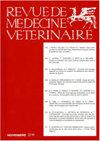Caracterización epidemiológica de la linfadenitis caseosa en rebaños caprinos de la península de Paraguaná, Venezuela
Q2 Veterinary
引用次数: 5
Abstract
Caseous lymphadenitis (CL) is a chronic infectious disease caused by Corynebacterium pseudotuberculosis ; it affects small ruminants and generates economic loss due to a reduction in weight, reproductive performance, milk and wool production forfeiture, and depreciation of skins. Given the socio-economic importance of goat production in the Falcon state (Venezuela), this research aimed to epidemiologically characterize the disease in herds in the Paraguana peninsula. The research is descriptive. Field work lasted six weeks, during which superficial lymph nodes were inspected, and 71 samples of purulent discharge were obtained from animals suspected to suffer from CL, according to their clinical manifestations. Back in the laboratory, specimens were bacteriologically analyzed; C. pseudotuberculosis isolates were compared with the reference strain ATCC 19410. The only risk factor detected for CL (p < 0.05) was the origin of goats by production units; those with the highest prevalence were located in the municipality of Falcon. Injuries in subscapular lymph nodes were the most frequent (p < 0.05) among the diagnosed animals. Penicillin, trimethoprim-sulfamethoxazole, and novobiocin-resistant strains were identified. These results are important to raise awareness among producers, given that this activity is of vital importance for the region and in many cases ignorance on the subject was evidenced.委内瑞拉paraguana半岛山羊干酪性淋巴结炎的流行病学特征
干酪样淋巴结炎(CL)是一种由假结核棒状杆菌引起的慢性传染病;它影响小型反刍动物,并造成经济损失,因为体重减少,繁殖性能下降,牛奶和羊毛生产被没收,以及皮肤贬值。鉴于猎鹰州(委内瑞拉)山羊生产的社会经济重要性,本研究旨在从流行病学角度确定巴拉圭半岛牧群中该病的特征。这项研究是描述性的。野外工作为期6周,检查浅表淋巴结,根据临床表现,从怀疑患有CL的动物身上获得71份脓性分泌物样本。回到实验室,对标本进行细菌学分析;将假结核杆菌分离株与参考菌株ATCC 19410进行比较。唯一的危险因素是山羊产地(按生产单位划分)(p < 0.05);患病率最高的位于法尔孔市。肩胛下淋巴结损伤发生率最高(p < 0.05)。鉴定出青霉素、甲氧苄啶-磺胺甲恶唑和新生物素耐药菌株。这些结果对于提高生产者的认识非常重要,因为这一活动对该区域至关重要,而且在许多情况下证明了对这一问题的无知。
本文章由计算机程序翻译,如有差异,请以英文原文为准。
求助全文
约1分钟内获得全文
求助全文
来源期刊

Revue De Medecine Veterinaire
农林科学-兽医学
CiteScore
1.30
自引率
0.00%
发文量
0
审稿时长
18-36 weeks
期刊介绍:
The Revue de Médecine Vétérinaire publishes four kinds of text:
1) Scientific reviews on subjects related to veterinary and comparative medicine. Suggested length: 10 to 30 typed pages.
2) Original reports on fundamental or applied research. Suggested length: 10 to 15 typed pages.
3) Continuous education articles, that should be easily understandable by non-specialists. Suggested length: 10 to 15 typed pages.
4) Clinical reports. Suggested length: 5 to 15 typed pages.
The publication can be done in French language or English language.
For an article written in English by not english native speakers authors, the manuscript must be subjected by attesting that it was read again by an anglophone scientist or a scientific translator.
The authors must certify that the manuscript was not published or subjected for publication to another review.
The manuscript must be accompanied by a sheet signed by all the joint authors indicating their agreement for the tender of the manuscript.
The publication is free but a financial participation could be required for the photographs color. An estimate will be sent to collect the agreement of the authors.
 求助内容:
求助内容: 应助结果提醒方式:
应助结果提醒方式:


